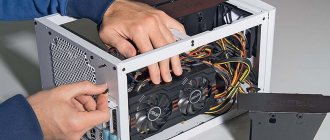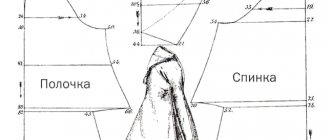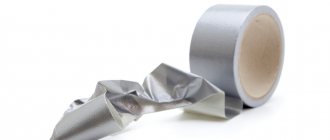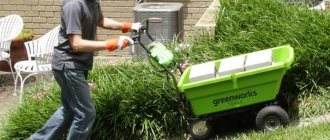Not everyone who wants to play sports has enough time to visit the gym, and home workouts require certain equipment, the cost of which is quite high. The most popular are dumbbells. They are involved in almost all exercises. And if you don’t plan to purchase sports equipment in the near future, you shouldn’t give up exercising. You can make dumbbells with your own hands from fairly cheap materials. To do this, just read the instructions on how and what they are made from.
DIY sports equipment: basic rules
You can make almost any sports equipment yourself, from simple weights to sports complexes.
The most common strength exercises can be performed at home with dumbbells.
The best, of course, are metal dumbbells, but they are much more difficult to manufacture than other designs. It is necessary not only to make the disks, but to choose the correct width of the pancakes, and to make the locking locks in a quality manner according to the calculations. You can make several heavy and several small pancakes.
The diameter of the bar (handle) must be within 3 cm; this condition must be taken into account when manufacturing dumbbells and barbells. Weights allow you to perform exercises of varying loads.
Before you start practicing at home, carefully check your equipment for the integrity of both collapsible and permanent products.
General recommendations
Before making dumbbells with your own hands, it is advisable to understand what this homemade equipment is and what specific workouts it will be intended for. Alternatively, you can use any objects that are comfortable to hold in your hands. However, they must have sufficient weight depending on the physical fitness of the athlete. You can make both small and large dumbbells with your own hands.
To ensure the maximum ratio between the effort applied and the result obtained, the weight of the dumbbells should be taken into account. For example, for beginners, homemade devices up to 2–3 kg may be essential, but for a systematic athlete, even five-kilogram options are unlikely to be useful. It is not possible to indicate the exact weight for each trainee, since complexion, age and other physiological factors play a huge role here. But there is one condition that you should focus on when making your own choice. A suitable weight is one with which it is already difficult to perform the exercises, but you still have the strength to do 2-3 repetitions.
You can achieve the desired weight of dumbbells using measuring instruments. To do this, the required amount of filler is weighed in advance, which is then poured into prepared containers.
With regular exercise, sports performance constantly changes, so you will have to monitor the number of approaches and repetitions. When certain results are achieved, it is worth thinking about increasing the weight of the equipment by 5 or 10%. Do-it-yourself dumbbells at home will help not only transform your body, but also build muscle mass. The basic set of exercises includes the following types of strength loads:
- standing or lying dumbbell press;
- squats;
- bicep curls;
- triceps extensions;
- dumbbell raises;
- lunges with dumbbells.
Before training, it is necessary to check the equipment for the integrity of all connections, as well as for its serviceability and absence of external damage.
What can be used from improvised means
People often stop playing sports due to lack of sports equipment. There is always a way out: any projectile can be replaced with a heavy object that is at hand. Some physical exercises do not require special equipment.
The most common equipment is an ordinary plastic bottle, from which I make dumbbells. To weigh them down, various fillers are used: water, crushed stone, sand, cement, small metal parts, etc.
Special benches
A special type of sports equipment is benches for hyperextensive exercises. Their goal is to achieve leanness and flexibility without gaining excessive muscle mass. In fact, hyperextension can be done on a large ball, or just on a mat, but the best results are obtained on a special bench.
Benches for hyperextension, due to anatomical and physiological differences, are available for men and women, see fig. A strong Amazon can do hyperextension exercises on a men’s bench, but ladies whose goal is to get rid of riding breeches, have a slender posture and a flat stomach only need a women’s bench for hyperextension, on the left side of the trail. rice. To start getting yourself in order without risking your reproductive health, it’s still better to sit on an inclined bench with a curved board, or do press exercises with a weight, also sitting on a special bench, on the right.
Note:
drawings of a bench for hyperextension with height adjustment are given in Fig. Materials – profile pipe 40x25x2, 35x15x1.5 and round 25x1.5; desk made of plywood 12-14 mm. For desk lining, see below.
Making dumbbells with your own hands
At home, you can make both small and large dumbbells.
The first step in manufacturing is to decide what they will be made of.
From plastic bottles
To make plastic dumbbells from plastic bottles, you will need the following materials:
- bottles (2 pcs. of the same volume);
- handle 30-40 cm long (wooden stick or metal rod);
- scotch tape (insulating tape);
- filler (sand, crushed stone, small metal parts).
After all the material has been prepared, you must:
- take bottles and fill them with filler;
- wrap the handle with electrical tape in the middle (10-15 cm);
- insert one end of the handle into the neck of the first bottle until there is no movement;
- to prevent the filler from seeping through, coat the joint of the handle with silicone or glue;
- connect the second bottle to the handle, then process the joint;
- wrap the assembled structure around the handle, strengthening the connection.
From cement
Heavier dumbbells are made using a cement base. The disadvantage of concrete dumbbells is that it is difficult to evenly adjust the weight of the weighted plates, and this design is not dismountable. If a different weight is required for sports, a new apparatus will need to be made.
In order to make dumbbells at home, you will need the following materials:
- metal pipe (neck);
- cement mortar;
- bolts, screws;
- form for casting pancakes.
Then you need to:
- At the ends of the neck, make four holes evenly for 4 bolts around the perimeter.
- Install bolts into the holes, which are holding elements for the pancakes.
- Place the bar in a vertical position in the casting mold. Pour in cement mortar and leave in this position until the mortar is completely dry.
- For the second side, repeat the previous step.
You can eliminate the flowability of cement dumbbells by adding PVA glue or paint to the solution, and to increase the weight - crushed stone, gravel or small metal products.
Metal
Shells made of metal are considered the most reliable and practical.
To make dumbbells you need:
- Prepare a metal rod with a diameter of 3 cm (bar).
- Take a thin-walled pipe 15 cm long. The internal diameter should be slightly larger than the diameter of the neck.
- Place the pipe on the bar, then fix it in the middle.
- Make the required number of weight discs. This will require sheet steel.
- Use rings or a 2-3 cm long pipe as locking locks. Drill a hole in them and cut a thread for screwing in a screw. As a result, the screw that is screwed in will hold the plates by pressing them against the bar.
Pay special attention to high-quality pressing of the screw to avoid play. Collapsible metal dumbbells allow you to adjust the weight. It is also possible to make non-separable dumbbells, for this purpose welding is used as locking locks.
Manufacturing
First you need to mark the board according to the drawing. In this case, you need to especially carefully mark the center of all future holes and prick them with an awl.
Then you need to drill all the holes. In this case, it is advisable to start by sawing a blind hole with a diameter of 26 mm with a hole saw.
To do this, you first need to cut it to about the middle of the board.
And then clean out this hole with a semicircular chisel.
Naturally, this must be done on two blanks of planks.
After this, it is necessary to widen the central holes on the planks with a drill with a diameter of 8 mm, and then cut through with a hole saw with a diameter of 80 mm, two large holes in each plank.
Well, then, you can cut out our two boards with a jigsaw.
I think this is pretty self-explanatory, so I won't go into too much detail about this process, otherwise it would be a very long article.
And now both of our boards are ready.
Now they need to be processed with sandpaper, and if necessary, refinished, that is, widen the large holes using a semicircular wood file.
In this case, it is necessary to ensure that the outer weights of the dumbbell fit freely into these holes.
Now you can screw screws into both planks (after drilling holes with a diameter of 3 mm for them), which will serve as legs.
We will need these legs so that the weight can be conveniently placed sideways on the floor or other surface. Although, in principle, you can do without screw legs here, if instead you simply make one side of each board not round, but straight. However, it seems to me that with legs our kettlebell will be more stable.
And now both of our boards are finally ready.
Now you can proceed directly to assembling our device for connecting dumbbells.
To do this, we will need two manufactured planks, as well as a long bolt or stud with an M8 thread and a length of approximately 30 cm, four washers, three M8 hex nuts and one M8 wing nut.
The tools you will need are two 13 mm wrenches, one open-end and one socket (or socket).
Well, secondly, such a round bolt head is quite safe, unlike a regular hex head, and even more so, unlike a simple stud. That is, if you accidentally touch it with some part of your body while doing physical exercises, you are guaranteed not to get skinned or scratched.
Therefore, if you use a regular bolt or pin to connect the boards, I advise you to make some kind of knob at the end of it, or simply wrap it better with electrical tape.
We assemble the device as follows:
First, screw a wing nut onto the bolt (almost to the round head of the bolt). Then we put on the washer and one of the boards with a blind hole with a diameter of 26 mm, upward. Then we put on another washer and screw on one of the hex nuts, which will serve as a limiter for lowering the top plate.
Then we screw another nut onto the end of the bolt and put on a washer. This is one of two nuts that will tighten the bottom plank.
Then we put the bottom plate on the bolt, followed by another washer and nut. We screw these nuts tightly with wrenches.
In this case, the lower tip of the bolt and nut should not protrude above the surface of the board, otherwise our weight will stand unevenly and unstable on the bottom board.
And now our device is ready.
Now we can insert dumbbells into it.
To do this, first unscrew the wing nut upwards as much as possible, and also lift the top plate and insert one dumbbell at a time.
Then, once the dumbbells are inserted, lower the top plate and press it with the wing nut, tightening it slightly.
And now our weight is ready.
Here she is standing on her side, in a position convenient for physical activity.
I must say that the weight turned out to be quite comfortable. In addition, it assembles and disassembles quite quickly, literally in 5-6 seconds.
Perhaps the only drawback of this weight (I mean my weight specifically) is that it turned out to be quite light, about 12.5 kg.
But there’s nothing you can do about it, since the weight of the kettlebell is equal to the total weight of two dumbbells, and mine weigh only six kilograms.
Naturally, if you have dumbbells weighing 8 or 10 kg, then the kettlebell from such dumbbells will be heavier (16 or 20 kg, respectively).
Although, in general, such a weight is enough for me, since I don’t “pump” but exercise simply to maintain good physical shape. And in this case, the lack of weight of the projectile can be completely compensated by increasing the number of repetitions.
How to make a barbell from improvised materials
You can make a barbell using available materials. Its design is practically no different in complexity from a dumbbell.
The main element is the bar; without it it is impossible to make a barbell. There are many options to make a barbell at home.
Plastic bottles
The design of a homemade barbell is identical to a dumbbell, and you can use bottles of water or other material for weighting. But for more serious weight loads, pancakes are made not from two bottles, but from 8 (4 on each side). The bottles are filled with filler, then 4 pieces are tightly fastened together, forming a square. After which the bar is installed in the space between the bottles and secured.
Wheels
Another easy way to make a barbell is to use car wheels as weights. As a rule, assembled wheels are used. This type of sports equipment allows you to throw the barbell onto the floor after performing an exercise, without fear of damaging both the barbell itself and the floor.
For such a rod, a plate with bolts is installed at the end in accordance with the bolt pattern of the disk.
Concrete pancakes
To make pancakes from concrete, you must first make a mold for pouring the solution. Place a cylindrical object in the center of the mold. The diameter of the cylinder should be slightly larger than the diameter of the neck. Then the cement mortar is diluted, which is poured into the mold until completely dry.
In order to make the rod more stable, it is necessary to install metal sheets (inserts) when pouring. All concrete weights for barbells must be made in pairs and have the same weight.
The bar must have a locking element that will prevent the plates from moving to the center. Additionally, locking locks must be made.
About sizes
Here in Fig. The dimensions of 3-support exercise machines for people of average height are given. On the left is a fully functional one with a removable desk, hand and foot levers. The main materials are corrugated pipe 60x40x2 and round pipe 30x2; stop for lifting the board – pipe 20x2. The board is 16 mm plywood with sheathing, as described below.
On the right is a simple compact one. The height of the bench above the floor is selected individually, measuring from the heel firmly planted on the floor to the inner bend of the knee joint. Basic materials as in the previous case; The adjustable rear leg allows you to transform the apparatus for seated exercises. But remember: the barbell from this simulator should only be lifted from the approach!
Instructions for assembling a homemade rod
The bar is the most important part, thanks to which the barbell is able to withstand heavy weight loads. The safety of performing exercises depends on the quality of the bar.
When making the neck, it is necessary to use durable materials. In order to make a fingerboard, you will need steel reinforcement, an iron pipe or a crowbar. When choosing a material, pay attention to the thickness, as it should be comfortable for a clenched palm.
The entire process of making a barbell at home can be seen in the video
Cans
Beginners can also make dumbbells using ordinary cans. The action is performed in stages:
- All jars should be selected not only in an even number, but also of the same size;
- Before work, the entire upper part is cut off;
- Next, it is important to prepare either an equal-sized stick or a pipe. If the handle is wooden, then it is better to take care in advance that it is intact so as not to damage the palm. The size of pipes or sticks is 25 cm, diameter is 3-4 cm;
- It is better to paint metal pipes by sanding them first;
- The prepared cement should be poured into jars;
- The pipe is placed in the middle, while at the ends that are immersed inside, it is better to screw self-tapping screws to avoid it slipping out during use;
- Hold it in one position for some time. Only after waiting for the solution to thicken can the pipe be released;
- It is better to leave the resulting dumbbells alone for a day so that the solution completely hardens.
The weight of such sports equipment will not be too large, but you should not increase it with fittings. They are ideal for beginner lessons.











